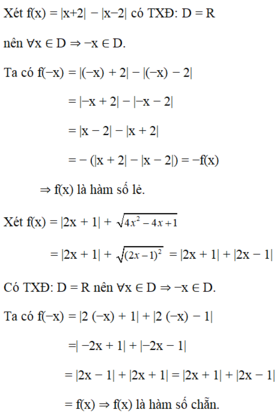Hãy nhập câu hỏi của bạn vào đây, nếu là tài khoản VIP, bạn sẽ được ưu tiên trả lời.

Hàm số ở câu a) \(y = 9{x^2} + 5x + 4\) là hàm số bậc hai với \(a = 9,b = 5,c = 4\)
Hàm số ở câu b), c) không phải là hàm số bậc hai vì chứa \({x^3}\)
Hàm số ở câu d) \(y = 5{x^2} + \sqrt x + 2\) không phải là hàm số bậc hai vì chứa \(\sqrt x \)

1: \(f\left(-x\right)=\left(-x\right)^2=x^2\)
Vậy: Hàm số này chẵn

Bài 1:
\(f\left(-x\right)=\left|\left(-x\right)^3+x\right|=\left|-x^3+x\right|=\left|-\left(x^3-x\right)\right|=\left|x^3-x\right|=f\left(x\right)\)
Vậy hàm số chẵn
Bài 2:
\(f\left(4\right)=4-3=1\\ f\left(-1\right)=2.1+1-3=0\\ b,\text{Thay }x=4;y=1\Leftrightarrow4-3=1\left(\text{đúng}\right)\\ \Leftrightarrow A\left(4;1\right)\in\left(C\right)\\ \text{Thay }x=-1;y=-4\Leftrightarrow2\left(-1\right)^2+1-3=-4\left(\text{vô lí}\right)\\ \Leftrightarrow B\left(-1;-4\right)\notin\left(C\right)\)

e: \(f\left(-x\right)=\dfrac{\left(-x\right)^4+3\cdot\left(-x\right)^2-1}{\left(-x\right)^2-4}=\dfrac{x^4+3x^2-1}{x^2-4}=f\left(x\right)\)
Vậy: f(x) là hàm số chẵn
\(c,f\left(-x\right)=\sqrt{-2x+9}=-f\left(x\right)\)
Vậy hàm số lẻ
\(d,f\left(-x\right)=\left(-x-1\right)^{2010}+\left(1-x\right)^{2010}\\ =\left[-\left(x+1\right)\right]^{2010}+\left(x-1\right)^{2010}\\ =\left(x+1\right)^{2010}+\left(x-1\right)^{2010}=f\left(x\right)\)
Vậy hàm số chẵn
\(g,f\left(-x\right)=\sqrt[3]{-5x-3}+\sqrt[3]{-5x+3}\\ =-\sqrt[3]{5x+3}-\sqrt[3]{5x-3}=-f\left(x\right)\)
Vậy hàm số lẻ
\(h,f\left(-x\right)=\sqrt{3-x}-\sqrt{3+x}=-f\left(x\right)\)
Vậy hàm số lẻ


Đáp án B
Vậy có 2 hàm số lẻ